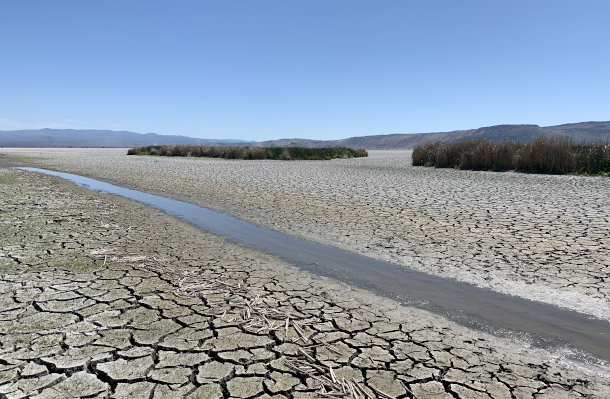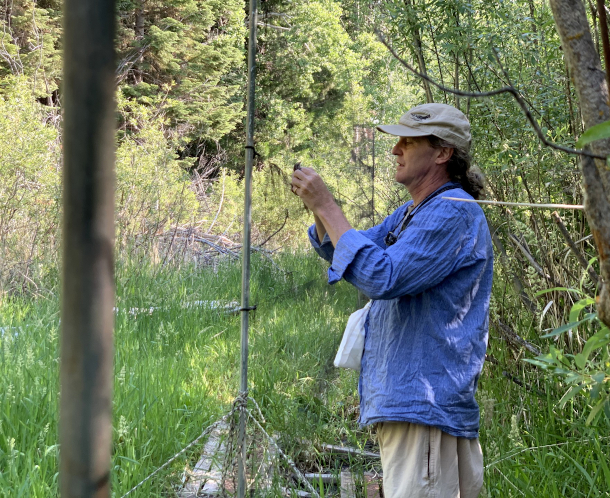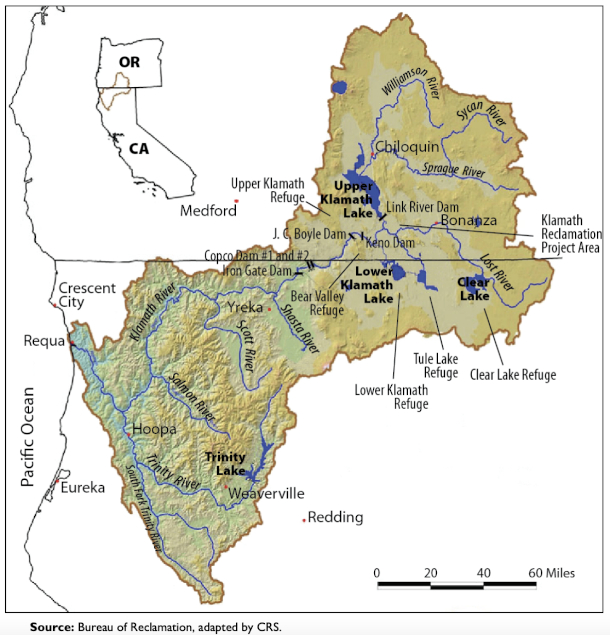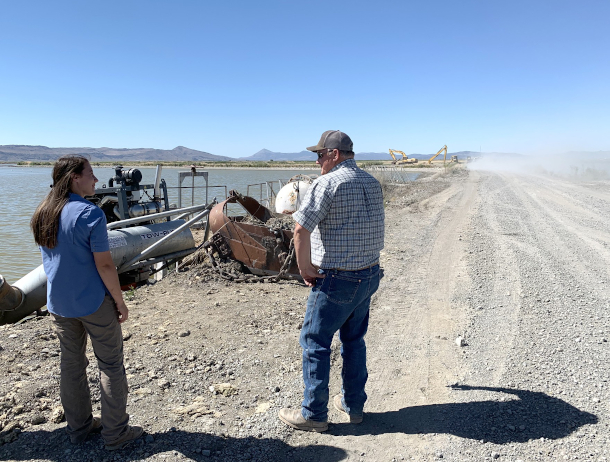Drought Threatens Migratory Birds
Air Date: Week of August 20, 2021

Sump 1A in the Tule Lake National Wildlife Refuge after being drained. (Photo: Erik Neumann/JPR)
Every year, over a million birds migrate to several National Wildlife Refuges along the Oregon-California border. But this year unprecedented drought and low water levels pose a serious threat to the survival of several migratory bird species. Erik Neumann from Jefferson Public Radio has the story.
Transcript
DOERING: Every year, over a million birds migrate to several National Wildlife Refuges along the Oregon-California border. But this year unprecedented drought and low water levels pose a serious threat to the survival of several migratory bird species. Erik Neumann from Jefferson Public Radio has the story.
(Sound up of walking through grass)
NEUMANN: John Alexander is walking along wooden planks on the marshy edge of Upper Klamath National Wildlife Refuge. Between the bullrushes and willows, a 10-foot-high black mesh net is set up to catch songbirds that are singing all around us.
ALEXANDER: Western Tanager, kind of in the back. Sweet, sweet, sweet, I’m so sweet. Yellow warbler, long distance migrant. Beautiful brilliant yellow bird.
NEUMANN: Alexander is the director of the Klamath Bird Observatory. He’s here with a group of research biologists surveying birds at their Upper Klamath Lake field station.

Klamath Bird Observatory Director John Alexander removes a bird from a mist net for their field station survey near Rocky Point on Upper Klamath National Wildlife Refuge. (Photo: Erik Neumann/JPR)
ALEXANDER: So, we write their band number down, and then they take information about the bird’s body condition, its size, how much fat is on it.
NEUMANN: They’ve been collecting data here since 1997. Alexander says water levels are noticeably low this year.
ALEXANDER: See where those sticks are laid up? That’s the normal water level this time of year.
NEUMANN: So where we’re standing right now, can you kind of describe what it would be like in the past?
ALEXANDER: I’d be waist deep in water, with chest waders on.
NEUMANN: Upper Klamath Wildlife Refuge is one of six refuges in the Klamath Basin. These marshes provide temporary habitat for countless songbirds and waterfowl that migrate as far as Mexico and Alaska.

Map of the national wildlife refuge complex in the Klamath Basin. Klamath Marsh Refuge not shown on map. (Image: U.S. Bureau of Reclamation)
NEUMANN: Amelia Raquel is a biologist with the sportsmen conservation group Ducks Unlimited.
RAQUEL: The basin as a whole in southern Oregon northeastern California in my opinion, and I think would be supported, is the lynchpin for migration habitat in the Pacific Flyway.
NEUMANN: But when the refuges are dry, that habitat is gone. In this highly managed basin, the refuges have been given the lowest priority for water, after local tribes and endangered fish, and farmers. That can have devastating consequences. Last year tens of thousands of birds died from avian botulism. The natural waterborne bacteria thrive in warm temperatures when water is low. This year’s drought is worse. So it’s prompting some creative solutions.
On a nearby dike that divides two wetlands in Tule Lake Wildlife Refuge, shallow water is being pumped from one side to the other. Raquel, with Ducks Unlimited, is working on the project with local farmers like Scott Seus.
SEUS: We’re taking what precious water is here and trying to accumulate it all into one spot to save 60-70,000 birds that perished last year that could be proportionately more than that this year.

Amelia Raquel with Ducks Unlimited and Klamath Basin farmer Scott Seus stand in front of a pump moving water from Sump 1A to Sump 1B on the Tule Lake National Wildlife Refuge. (Photo: Erik Neumann/JPR)
NEUMANN: The hope is that by collecting the shallow water in one area, they’ll ward off another major botulism outbreak. Refuge managers from the U.S. Fish and Wildlife Service declined an interview request for this story. While there’s more attention on the drought in the Klamath Basin this year, in reality, it’s not the only reason the refuges don’t have water.
COLE: I don't go to the refuge's too often anymore because there's not a lot to see. It doesn't change much. It's pretty dry.
NEUMANN: That’s Ron Cole. He worked at the refuges for the Fish and Wildlife Service for 26 years, much of it as a manager. Cole says the local water rights and the endangered species act, which protects several species of nearby fish, have deprived the refuges of the water they need to create functioning wetlands, even during normal water years.
COLE: Thank God, we have the Endangered Species Act to help save these species. But we have to implement it in such a way that we don't create more of the same elsewhere.
NEUMANN: The refuges also do have some water rights, on par with those of farmers. One for Lower Klamath Wildlife Refuge dates back to 1905. But, Cole says, the federal agencies, the Bureau of Reclamation and Fish and Wildlife Service, could never agree on how to get that water to the refuge.
He says, when the refuges can get water, managers are good at creating habitat for birds and recreation for people.
COLE: We do know how to do those things and it worked and it wasn't broke, but we broke it. We broke it. And that's the saddest part of all of it is we broke that refuge and I'd like to see us put some effort into fixing it.
NEUMANN: Going forward, he says, whether in drought years or not, all the different groups in the basin need to find ways to work together with the limited water that exists if anything is going to change.
I’m Erik Neumann, reporting.
DOERING: Erik Neumann’s story comes to us courtesy of Jefferson Public Radio.
Links
JPR | Out of the Spotlight, Thousands of Birds Face a Dry Year at Klamath Basin Refuges
Living on Earth wants to hear from you!
Living on Earth
62 Calef Highway, Suite 212
Lee, NH 03861
Telephone: 617-287-4121
E-mail: comments@loe.org
Newsletter [Click here]
Donate to Living on Earth!
Living on Earth is an independent media program and relies entirely on contributions from listeners and institutions supporting public service. Please donate now to preserve an independent environmental voice.
NewsletterLiving on Earth offers a weekly delivery of the show's rundown to your mailbox. Sign up for our newsletter today!
 Sailors For The Sea: Be the change you want to sea.
Sailors For The Sea: Be the change you want to sea.
 The Grantham Foundation for the Protection of the Environment: Committed to protecting and improving the health of the global environment.
The Grantham Foundation for the Protection of the Environment: Committed to protecting and improving the health of the global environment.
 Contribute to Living on Earth and receive, as our gift to you, an archival print of one of Mark Seth Lender's extraordinary wildlife photographs. Follow the link to see Mark's current collection of photographs.
Contribute to Living on Earth and receive, as our gift to you, an archival print of one of Mark Seth Lender's extraordinary wildlife photographs. Follow the link to see Mark's current collection of photographs.
 Buy a signed copy of Mark Seth Lender's book Smeagull the Seagull & support Living on Earth
Buy a signed copy of Mark Seth Lender's book Smeagull the Seagull & support Living on Earth

